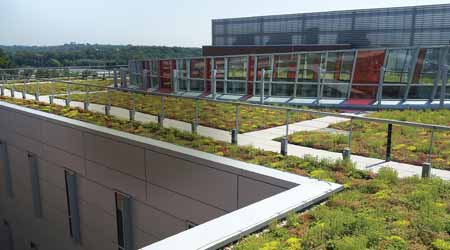 Vegetative roofs at the University of Maryland have provided energy-efficiency and aesthetic benefits to the campus.
Vegetative roofs at the University of Maryland have provided energy-efficiency and aesthetic benefits to the campus.Roofing: University Finds Opportunity in Vegetative Roofs
The University of Maryland embraces vegetative roofs that deliver benefits beyond sustainability.
The pressure to operate more sustainably continues to mount for commercial and institutional facilities. Universities in particular are expected to implement the latest products and equipment as part of their efforts to attract students, recruit faculty, and achieve bottom-line goals.
Among the sustainable technologies that engineering, maintenance and grounds managers in higher education are embracing are vegetative roofs. Planted over a waterproof membrane, the roof can offer several benefits to a facility, including stormwater control, energy savings and aesthetics.
In 2008, the University of Maryland at College Park, installed its first vegetative roof — a 6,000-square-foot installation — on Cumberland Hall. To date, the university has installed nine roofs totaling more than 40,000 square feet on five buildings. For the university, a high priority in installing vegetative roofs has been stormwater mitigation.
“In most cases vegetative roofs are considered an alternative surface in terms of stormwater management,” says Karen Petroff, the university’s assistant director of arboretum and horticulture services. “We have relatively little ground plane areas to deal with environmental site-design stormwater responses. On a particularly tight construction site, the likelihood of a vegetative roof increases tremendously.”
Identifying opportunity
Of the campus’s nine vegetative roofs, seven have been part of new construction projects, while two were installed on existing buildings — Cumberland Hall and the Adele H. Stamp Union building. Built in 1963 Cumberland Hall was the first building on campus to feature a green roof.
To identify existing buildings that could support a vegetative roof, the facilities management department worked with an outside consultant. The consultants conducted a structural analysis of Cumberland Hall to determine which portions of its roof could support a roof’s added weight.
“After the structural analysis, they determined that the center portion of the roof could tolerate a green roof structure,” says Michael Carmichael, the university’s stormwater management and maintenance inspector. “There were six other portions of the roof that could bear the additional weight of a green roof. The whole roof in its entirety was not able to sustain that weight.” The consultants then drew up plans for the different cells of the green roof.
“As these designs come in from outside consultants, we have a review team within the facilities maintenance department, and in a few cases, there have been add-ons during the construction process,” Petroff says, referring to vegetative roofs. “Typically, the university has not elected to put these roofs on older buildings only because that involves the re-engineering of the roof. When a roof has needed to be replaced, a green roof has been considered.”
The plants installed on a vegetative roof can vary depending on the local climate, as well as the desired roof system. An extensive roof system features 6 or fewer inches of media, or soil, while an intensive system features more than 6 inches of media.
“One of the things that we’re looking for when it comes to vegetation is coverage. The kind of vegetation selected depends on the kind of roof you have,” Petroff says. “Largely, the difference is the depth of media and to some extent the composition of the media. We have had a number of roofs installed on campus that have what I’ll say is an evolving media mix.”
Since 2008, the university has amassed a good amount of data on the types of vegetation that perform well on campus roofs and those that do not.
“We now have a very good feedback loop as how to improve this process going forward based on what we are seeing with the maintenance at this point,” Petroff says. “Some early roofs had some media failures, which led to vegetation failures. Once the media was corrected, then the original vegetation was perfectly acceptable. It’s a marriage of the design condition, the installation and then the maintenance afterward.”
Related Topics:














